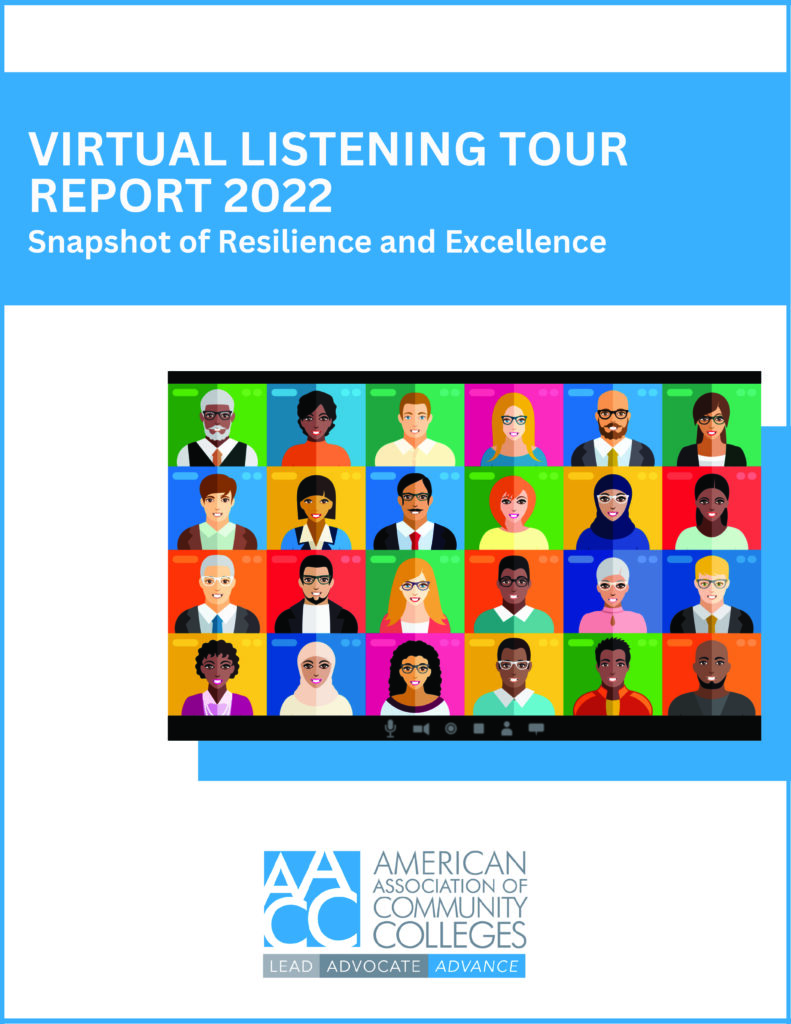A new American Association of Community Colleges (AACC) report summarizes the challenges that community colleges faced during the Covid pandemic as well as their responses. It covers a broad area, including enrollment declines, the equity agenda, pandemic excellence and partnerships, and the changing landscape and emerging competition.
The 20-page report pulls together information gathered during AACC’s virtual listening tour in 2021 and 2022, which engaged community college CEOs from 45 states. The report is grouped into broad categories with brief examples of various programs and efforts that two-year colleges and other related organizations undertook to address those issues, with many of them continuing today. AACC will use the information to help guide the association in identifying priorities for its member colleges and how AACC can support them.
Lingering challenges, promising practices
The report leads off with enrollments, which were already declining for several years at community colleges prior to the pandemic. Covid accelerated the drop as many students went into “survival mode” and put college on hold. The report lists several notable approaches to address these decreases, including dual-enrollment programs, which a growing number of community colleges were expanding prior to the pandemic, and career academies. It cites programs such as Montana Project 10, which is patterned on the successful CUNY Accelerated Study in Associate Programs, and in Kentuck the Madisonville Community College Accelerator program, which is geared toward adult learners.
The AACC report notes several new and expanded programs in the academic and workforce areas, which include cybersecurity, professional addiction counseling, direct entry midwife, drones and the cannabis business.
Related to enrollment is a relief for students. This section is broken down by tuition, fees, textbooks and operating hours, as well use of data and student support services that include online orientation, remote academic advising and success coaches. It also posts practices on addressing food and housing insecurities and student mental health.
Another section of the report focuses on equity efforts, from professional development to assessments of programs. Included here is a list of centers and instructional resources for equity that colleges have used. The report also provides brief descriptions of equity-focused programs, such as the Black Men in K-12 Teaching Pipeline at Normandale Community College (Minnesota) and the Honors Program run at Mississippi community colleges, among others.
Looking ahead
The report concludes by addressing emerging changes that community colleges are facing, from the continued threat of cybersecurity issues — such as ransomware — to accreditation, uses of space at campuses and facilities, and growing competition from four-year colleges and the private sector.
On accreditation, college leaders have told AACC that the current accreditation approach has not nimble enough.
“New programs offered in non-traditional ways have received pushback from regional accreditors even though colleges have to remain adaptable, flexible, and nimble in preparing workers for the current and future jobs that will exist,” the report says.
In terms of using space on campuses and facilities, many colleges are rethinking how to use them as the modality of instruction is shifting. The adaptations needed during the pandemic have opened the desire among more students to take programs remotely, which has colleges looking at how they use their space on campus and in buildings.
College leaders also shared their views on competition facing the two-year sector. Historically, for-profit institutions have been a main competitor for community colleges, but more recently four-year institutions are entering areas that have typically been the domain of two-year colleges, the report says.
“Since the pandemic began, universities have been aggressive in offering associate degrees and workforce development programs, which community colleges would argue is the mission of community college,” it says.
There is also growing competition from the private sector. The report observes companies such as Google and Amazon Web Services have created their own curriculum but have not yet mastered comprehensive delivery. It adds that in order to remain competitive with these companies, some community colleges have opted to work with them and embed the curriculum in their own offerings.


